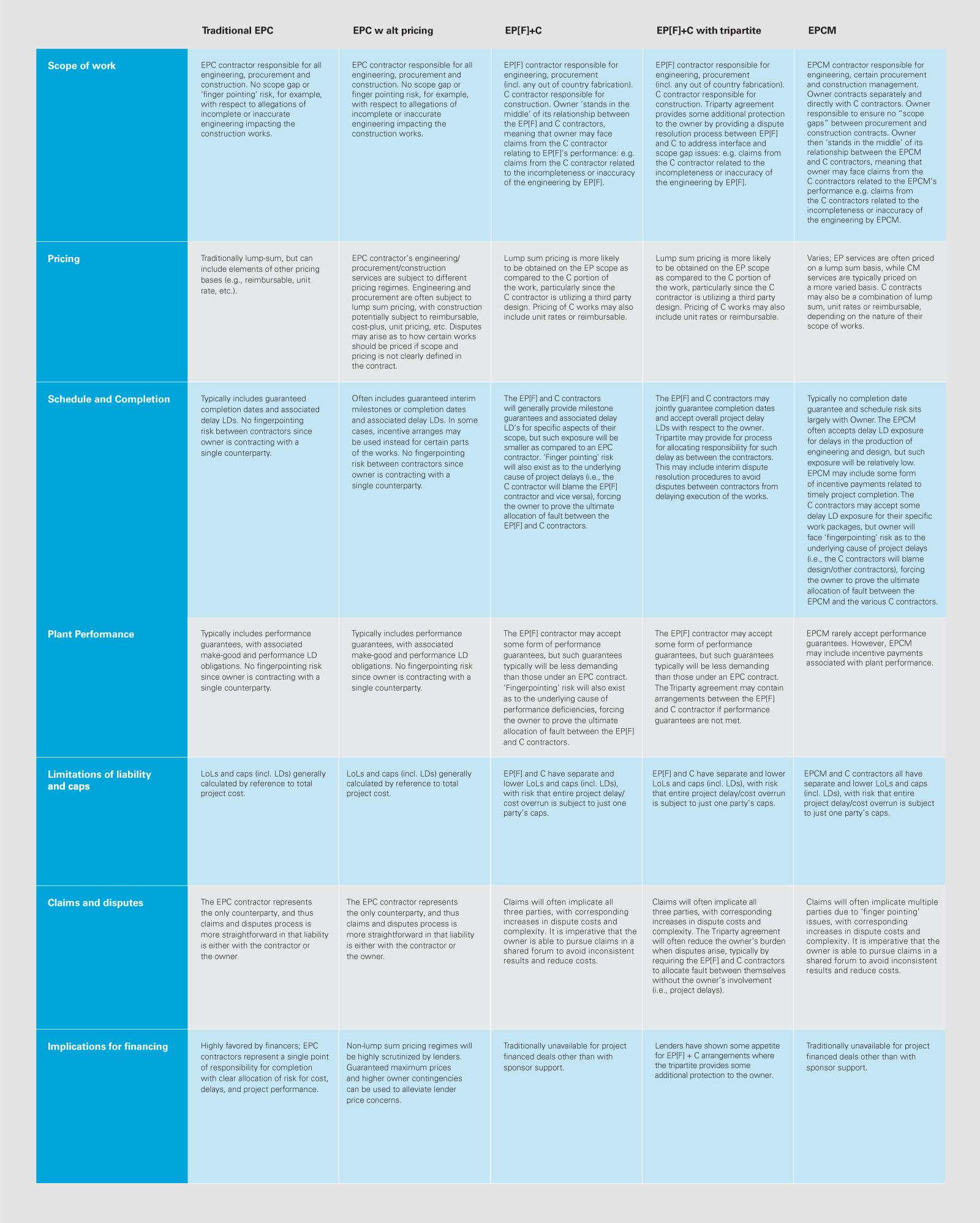
Subscribe
Stay current on your favorite topics
The authors would like to thank Mike Denning, a senior executive at INPEX, and Carl Strickler, Managing Director for Power and Alternative Energy at Glenfarne Group, for their contributions to this article.
The growing complexity of energy projects—coupled with stories of major cost overruns—has sparked a growing reluctance among contractors to sign up to EPC contracts on a lump-sum turnkey basis. Project owners are starting to think laterally about how to keep contractors on board, while maintaining the financial viability of their biggest projects.
Former San Francisco Mayor Willie Brown once remarked that "in the world of civic projects, the first budget is really just a down payment." Although referring to San Francisco's Transbay Terminal project at the time, some might argue the observation holds particular resonance for mega energy projects as well.
Over the past decade, a number of well-publicized examples of major cost and time overruns have plagued the energy sector, including liquefied natural gas (LNG), petrochemical, nuclear and renewable projects around the world.
These examples have become less and less exceptional. Bent Flyvbjerg, a professor in major programme management at Oxford University's Saïd Business School, believes nine out of ten mega construction projects (across all sectors, including energy) cost more than anticipated, with overruns of more than 50 percent in real terms not unusual.
This theme has been exacerbated over the past 12 to 18 months due to the impact of COVID-19 and rising material costs, which reached 40‑year highs in 2021 as a result of post-COVID demand spikes and supply chain bottlenecks, and increasingly complex deliverables.
Increasing project scale and complexity, and a growing list of budget blowouts are reshaping the dynamic between project owners and contractors
50%
Cost of overruns of more than 50 percent are not unusual in mega construction projects
Source: IEA
The significance of the changing risk dynamic
Increasing project scale and complexity, and a growing list of budget blowouts are reshaping the dynamic between project owners and contractors and making it increasingly challenging for project owners to convince contractors to take on work on traditional terms.
Historically, the developers of mega energy projects could rely on lump-sum engineering, procurement and construction (EPC) contracts for project procurement. These EPC contracts, a cornerstone of securing project financing, traditionally allocated clear and substantial risk to the main contractor. Even though this transfer of risk meant higher costs for owners (the overhead, profit and contingency mark-up on the project costs for a lump-sum EPC can be significantly more than for procurement models where more risk sits with the owner), the trade-off for less risk exposure for the owner was a significant factor in giving project finance providers the necessary levels of comfort.
The increasing scale and risk of mega energy projects in recent years, however, has proved too much for some contractors to accept on a lump-sum turnkey basis with a guaranteed schedule. Indeed there have been a number of high-profile examples in recent years of major international construction contractors being pushed to the brink of collapse as a result of suffering significant losses linked to cost overruns and delays on such projects. As a result, a number of international engineering and construction firms have tapped down or even exited the lump-sum EPC business altogether to avoid similar outcomes.
"Lump-sum EPC contracts are still very much a feature of the market and will still be agreed by contractors, but contractors are aware of some of the bad outcomes and some won't be willing to take on the risk," says Carl Strickler, Managing Director for Power and Alternative Energy at Glenfarne Group, an owner and operator of energy and infrastructure assets.
Mike Denning, a senior executive at INPEX, a Japanese-based multinational energy company with a global portfolio of projects, adds that regional differences will come into play. Large owners in regions like the Middle East continue to secure EPC lump-sum terms, but in Australia, where there is a pool of big, sophisticated subcontractors, turnkey deals are rarer."
"Specific regional considerations aside, arrangements where risk sits across both owner and contractor are becoming more common. Clients have to be more flexible and structure deals in a way that maximizes the number of contractors willing to take on the work," Denning says.
The change in contractor appetite for risk represents a new and significant obstacle for developers of both mega energy projects and mid-scale projects throughout the world, with contractor reluctance to take on lump-sum turnkey projects creating friction between contractor and lender risk tolerance.
40-year
40-year high material costs: Rising material costs reached 40-year highs in 2021 as a result of post-COVID demand spikes and supply chain bottlenecks.
US$530bn
Global project finance stood at US$529.8 billion – a 38. 4% growth compared to 2019 pre-pandemic levels and the highest yearly value since 2017
Source: IJGlobal
The need for creative solutions
Owners and contractors have started to become more creative about procurement structures, with some projects pivoting away from traditional lump-sum EPC structures in an effort to recognize the impact of higher risk on contractors and the decreasing pool of contractors prepared to take that risk.
Creative thinking to address changing market conditions and increased risk in a fair and sensible way should be encouraged in the current market. But untethering from familiar lump-sum EPC contracts requires careful thought and planning.
There is a range of alternative contractual structures that owners and contractors can consider in order to navigate changing market dynamics. These structures will sit along a spectrum of risk, with a traditional EPC structure, which traditionally assigns the most risk to the contractor, at one end, and EPCM (engineering, procurement and construction management) structures, which allocate more risk to the owner, at the other. The table included at the end of this article identifies five alternative procurement structures along this spectrum and summarizes some of their key distinguishing features.
The new 'hybrid' structures attempt to find a balance between owners and contractors by either assigning different pricing components to different phases of work (engineering and procurement services with less inherent risk priced as a lump sum, while construction work with more inherent risk priced on a unit rate remeasure or reimbursable basis) or splitting out work between different contractors, with, for example, the engineering and procurement being handled by the technology provider and a regional construction specialist handling the onsite construction works.
These alternative structures have become more common on large energy projects in recent years. On top of the five structures we have outlined, we have seen many more examples of mixing and matching various elements of these structures into bespoke contractual arrangements. Finding the right balance must be done on a case-by-case basis, and what is right for each project will vary.
In addition to the implications for financing and the revisions to the terms of the contract required to implement the new risk allocation, including any structural changes to the contract, it is important that parties consider how the changes they are making might impact the performance and management of the works, particularly with respect to unexpected events that arise, and the parties' respective motivations to address the consequences. Parties cannot afford to impose rigid templates and assume that simply allocating risk differently will be a cure-all. It is important that construction contracts not only allocate the risk of events, but also facilitate and motivate constructive behavior by the parties to mitigate the consequences of events.
The new alternative structures attempt to find a balance between owners and contractors by either assigning different pricing components to different phases of work or splitting out work between different contractors
It is important that construction contracts not only allocate the risk of events, but also facilitate and motivate constructive behavior by the parties to mitigate the consequences of events
Adapting to new structures
As the industry transitions to more bespoke procurement structures, the need to thoroughly scope out the work required, anticipate where trouble spots could emerge, and provide processes and incentives for managing such risks, is becoming even more crucial to the preparation of the contracts.
Traditional EPC and EPCM contracts are generally well understood, and the allocation of risks and responsibilities under these structures has been developed and refined over decades of experience. Sophisticated procedures have been developed to manage risks within those understood paradigms.
However, with the use of new "hybrid" procurement structures (often derived from a template EPC), risk allocation can shift without the full consideration or understanding of the parties, leading to misunderstandings and inconsistent interpretations of the contract, and ultimately disputes.
Glenfarne's Strickler says these risks can be mitigated by upfront preparation specifying each party's responsibilities in the maximum possible detail.
"I'm a big believer in fully documenting the scope of work and the scope of responsibility, clearly defining every aspect you possibly can. It takes a lot more time, a lot more money, and legal dollars to get it. But I tell you, it saves a lot of arguing, and a lot of money," Strickler says.
Identifying the most common causes of major delay and cost overruns is particularly important when parties are considering new, bespoke procurement structures. It is essential that parties give thought to how their contract will operate if these issues arise.
In this regard, it is relevant to note that most of the project cost tends to sit in the construction phase, which is also the phase of the works most exposed to external factors and thus hardest to control. Some key external construction risks will vary from region to region. In less-developed and remote sites, there can be shortages of skilled and reliable labor, as well as security concerns. More-developed markets can face unpredictable labor costs and tight labor markets. Trade unions and dominant subcontractors can also make some developed jurisdictions challenging. Unpredictable environmental and weather impacts—as well as onsite soil and subsurface conditions—are also common causes of delay and cost overrun.
In addition to these external risks, cost blowouts and delays in the construction phase will also arise from factors within the control of project owners and contractors. These include delayed and incomplete engineering, owner-directed changes to the work, lower than planned site productivity, and coordination of the interfaces between various subcontractors, trades, management and joint venture partners.
Identifying as many potential risks as possible early on and addressing how to deal with these eventualities in contracts can go a long way to mitigating overruns and reducing the number of disputes.
Irrespective of whether the occurrence of a particular event is within the parties' control, the management and mitigation of the consequences of those events can be controlled, and is crucial to the success of the project. Most, if not all, projects experience unplanned events, but the parties' reaction to those events and management of the resulting consequences is often the greater determinant of the extent of delay and cost overrun.
A successful procurement structure must therefore encourage efficient and timely execution of the works. Irrespective of which party may be allocated a particular risk, it is important that the contract structure be such that it facilitates and incentivizes the mitigation of total project time and cost.
It is essential that when moving away from a traditional EPC contract structure that the parties consider how the new structure may affect the conduct and motivations of the parties during the course of the works. For example, if the owner is taking on risks traditionally carried by the contractor and which are dependent on the conduct of the contractor, the parties should consider the following:
- What other mechanisms can be included in the contract to motivate the contractor to manage the works to reduce costs and delay that may be considered at the owner's risk. This is an issue where drafters may be able to take some inspiration from EPCM contracts. For example, by linking parts of the compensation to Key Performance Indicators and the use of early completion bonuses and the sharing of cost savings.
- What additional reporting and project controls might the contractor need to maintain to ensure the owner has the information it needs to properly manage the additional risk it has been allocated. Relatedly, the owner must be realistic about its ability to manage these risks and must ensure it structures its project team to reflect the increased management and oversight it will need to take on in respect of the relevant works.
- Whether it is appropriate to adjust the percentage P&OH payable to the contractor for those parts of the works for which the contractor is carrying less risk. This reflects the fact that the owner will need to carry additional contingency for these parts of the works.
It should also be recognized that interfaces between parts of the works being executed on different pricing arrangements can create unintended dynamics that can be prejudicial to the project. Owners will prefer that more of the costs be incurred in parts of the work priced on an lump sum basis, whereas the contractor will want the costs to fall within parts of the works priced on a time-and-materials or reimbursable basis. This may lead to competing interpretations of the contract and/or increased issues with "carryover works." Similarly, where these different pricing arrangements create different criteria for a contractor to establish a claim to be paid for increased costs, the parties may have conflicting motivations when it comes to identifying and reporting the root cause of delay and disruption. A good work breakdown structure (WBS) is of course important for addressing these issues, but equally important is that schedule, quantities and cost reporting is accurate and reliable, and makes use of the WBS.
When deviating from the EPC lump-sum model, INPEX's Denning says forensic attention to detail is required to avoid "disconnects" between different contractors, subcontractors and owners. When curating a hybrid contract, it is vital that the contract aligns with the practical parameters of the project.
"Something can appear fully articulated from a lawyer's perspective but from an engineer's perspective may not be defined at all. Establishing where the scope sits can be more elusive than assumed," Denning says. "Between separable portions of a project, you have a pipe running, and then suddenly more equipment and infrastructure is needed, and it hasn't been articulated. This is where problems and blowouts occur. Problems usually emerge at interfaces. You already have many external interfaces. Avoiding internal interfaces is important for reducing complexity."
Glenfarne's Strickler has observed positive outcomes by establishing a tri-party group as part of the contract. This group serves as a forum to address any disputes that arise between owners, contractors and subcontractors, and can anticipate friction points.
"You can have big, experienced and financially capable entities on board, and you can get the liability caps to match up. It looks good on paper, but it doesn't deal with things that happen at interfaces between different parties. That is where a tri-party agreement is so valuable," Strickler says.
Building the new
It is a positive reflection on the industry that procurement structures in the energy sector continue to evolve to adapt to the changing nature of projects, the parties involved and the environments in which the works are being executed. Finding the right risk allocation for each project and the parties involved is key and there is no one-size-fits-all. That said, what form of procurement structure is "bankable" in the eyes of lenders will remain a fundamental driver for structuring the procurement of these projects.
It is essential, however, that in developing these new procurement structures that parties give careful consideration to how the changes to the traditional risk allocation will affect the working relationship between the parties. Parties must seek to develop a new framework that facilitates a productive working relationship and that encourages timely and efficient execution of the works. In the words of Socrates, "The secret of change is to focus all of your energy not on fighting the old, but on building the new."
Download full report 'Building the new: Creative solutions for procuring major energy projects' PDF
White & Case means the international legal practice comprising White & Case LLP, a New York State registered limited liability partnership, White & Case LLP, a limited liability partnership incorporated under English law and all other affiliated partnerships, companies and entities.
This article is prepared for the general information of interested persons. It is not, and does not attempt to be, comprehensive in nature. Due to the general nature of its content, it should not be regarded as legal advice.
© 2022 White & Case LLP

 View full image (PDF)
View full image (PDF)
